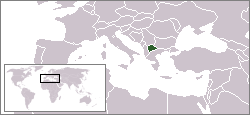The Republic of Macedonia, known by most international organizations and foreign states as the Former Yugoslav Republic of Macedonia (FYROM)1, is an independent state on the Balkan peninsula in southeastern Europe.
The Republic contains roughly 38% of the area and nearly 44% of the population of the geographical region known as Macedonia, the remainder of which is divided between neighbouring Greece (with about half of the total) and Bulgaria (with under a tenth). The lands governed by the Republic of Macedonia were known as the Vardarska banovina before 1945. Between 1945 and 1991, the Socialist Republic of Macedonia was one of the six constituent republics of the Socialist Federal Republic of Yugoslavia.
| |||||
| National motto: .. | |||||

| |||||
| Official languages | Macedonian | ||||
| Capital | Skopje | ||||
| President | Branko Crvenkovski | ||||
| Prime Minister | Hari Kostov | ||||
| Area - Total - % water |
Ranked 145th 25,713 km² 1.9% | ||||
| Population - Total (2003 est.) |
Ranked 140th 2.022.547 | ||||
| Independence | 8 September 1991 | ||||
| Currency | Macedonian Denar (MKD) | ||||
| Time zone | UTC +1 (DST +2) | ||||
| National anthem | Today Over Macedonia | ||||
| Internet TLD | .mk | ||||
| Calling Code | 389 | ||||
Naming dispute
Following the Republic of Macedonia's independence, the Greek government raised objections concerning:
- The name: Macedonia was claimed by Greece to be a Greek name,
- The flag: the sixteen-ray "Vergina Sun" star that was on the flag was a symbol of the ancient state of Macedon, to which Greece claimed to be the sole heir,
- The constitution: a reference in Article 49 to the Republic caring "for the status and rights of those persons belonging to the Macedonian people in neighboring countries, as well as Macedonian expatriates, assist[ing] their cultural development and promot[ing] links with them," which Greece interpreted as encouraging separatism among its own Macedonian Slav minority.
As a result, the United Nations recognized the state in 1993 under the temporary reference of "the former Yugoslav Republic of Macedonia" and other organizations soon followed. As part of an agreement to lift a Greek embargo imposed in February 1994, the Republic changed its flag to an eight-ray sun and amended its constitution to renounce territorial ambitions.
The state's name remains a source of local and international controversy. A permanent agreement on how the Macedonian republic should be referred to internationally has not yet been reached. Most diplomats are accredited to the republic using the FYROM designation. At the same time, at least 40 countries have recognised the country by its constitutional name – the Republic of Macedonia, rather than FYROM. Given the long name, the state is often referred to as Macedonia colloquially and by most non-Greeks despite the ambiguity of the term with the region of Macedonia.
See also: Naming dispute between FYRoM and Greece
History
Main article: History of the Republic of Macedonia
The lands governed by the Republic of Macedonia were known as the Vardarska banovina between 1929 and 1945, and as Socialist Republic of Macedonia between 1963 and 1991. The conflict over its official name arose soon after the declaration of independence, and as of 2004 it still persists.
The Republic remained at peace through the Yugoslav wars of the early 1990s, but the influx of an estimated 360,000 ethnic Albanian refugees from the neighbouring Kosovo in 1999 threatened to destabilize the republic. A brief armed conflict in March 2001 involving Albanian rebels in the west of the country ended with the intervention of a small NATO ceasefire monitoring force and government undertakings to concede greater rights to the Albanian minority.
On February 26, 2004, President Boris Trajkovski died in a plane crash. The results of the official investigation revealed that the cause of the plane accident was procedural mistakes by the crew, committed during the approach to land at Mostar airport.
Politics
Main article: Politics of the Republic of Macedonia
The Republic of Macedonia is a parliamentary democracy with an executive government composed of a coalition of parties from the unicameral legislative (Собрание, Sobranje), and an independent judicial branch with a constitutional court.
The local government is organized in 123 municipalities.
Geography
Main article: Geography of the Republic of Macedonia
The terrain is mostly rugged, located between the Šar and Rhodope mountains around the valley of Vardar.
The area is seismically active and has been subject to destructive earthquakes in the past.
Economy
Main article: Economy of the Republic of Macedonia
The Republic was the poorest area of the former Yugoslavia, and was faced with considerable economic difficulties until the late 1990s due to economic and political problems with some of its main export partners. It has since made a sluggish recovery, though the extent of the unemployment and gray market continue to be of grave concern.
Demographics
Main article: Demographics of the Republic of Macedonia
The mother tongue of some 1.3 million of the state's inhabitants, the so-called Macedonian Slavs, is Macedonian, a south Slavic language related to Old Slavonic. Albanian is spoken by around 500,000 people and Turkish by 80,000. There are an estimated 120,000 Romany speakers.
Culture
Main article: Culture of the Republic of Macedonia
See also:
Miscellaneous
External links
Official government sites
- Official Government website
- Ministry of Defense
- Ministry of Foreign Affairs
- Ministry of Culture
- Ministry of Finance
- Ministry of Economy
- Ministry of Transport and Communications
- Ministry of Agriculture, Forestry and Water Resource Management
- Ministry of Labor and Social Policy
- Ministry of Education and Science
- Ministry of Health
- Ministry of Local Self-Government
- Ministry of Environment and Physical Planning
Other, unofficial web sites
Notes
¹ The title of this article is not meant to imply an official position on this naming dispute.